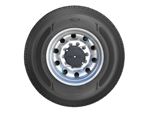Using Benchmarks to Improve Fleet Operations
A benchmark is something that can be used to judge the quality or level of other, similar things. As such, a benchmark is a very nice thing for a fleet professional to have when some difficult questions are being asked. Are we competitive? When should we replace our equipment? Exactly how many technicians do we need to effectively maintain our equipment?
Those are three questions that Chris Shaffer, one of the founding partners of Utilimarc (www.utilimarc.com), believes fleet managers should be answering at least annually. His company analyzes fleet data and, using its proprietary analytic software, generates a number of management tools. Benchmarks are one of those tools.
If you’re going to compare your performance with supplied benchmark data, keep in mind that it’s essential to compare apples to apples. “We have found that it’s very important to benchmark like vehicles doing like work in like applications,” Shaffer said. “If you consider, for example, a heavy-duty bucket truck, it’s important to compare yours with trucks in other fleets that have exactly the same kind of truck doing exactly the same kind of work.”
Michael Riemer, vice president of products and channel marketing at Decisiv Inc. (www.decisiv.com), echoed the importance of benchmarking on a regular basis. “It can greatly help improve the performance of maintenance operations and generate greater returns on investment in assets and personnel,” he said. “Regularly scheduled benchmarking enables fleets and their service providers to compare their performance with competitors and best-in-class performers. This analysis can help fleets better prioritize and measure key maintenance initiatives.”
Both Utilimarc and Decisiv represent fleets totaling more than 300,000 vehicles. As a result, both are capable of generating meaningful data that fleet professionals can use to benchmark their operations. There are, however, other opportunities available that enable fleets to generate yardsticks against which their performance can be compared.
One Fleet Association’s Approach
One example of other benchmarking opportunities comes from Frank Castro, transportation manager for the Snohomish County Public Utility District based in Everett, Wash. The utility’s fleet consists of light pickup trucks, Class 8 vehicles and everything in between. Castro participates in a regional professional group – the Northwest Electric Utility Fleet Managers Association (NEUFMA) – which represents 5,000-plus vehicles throughout Idaho, Washington and Oregon.
Regarding the organization’s benchmarking activities, Castro said, “If you’re just looking at your own fleet, how do you really know if you’re doing a good job unless you can compare against another organization? Maybe the best scenario would be to compare against a much larger organization.”
NEUFMA members realized that they already had the much larger organization they needed in the form of their association, which meets quarterly but has more frequent contact through email. As a result, they decided to generate a list of fleet-related issues that all members were asked to respond to at their meetings. The idea was to have a discussion about the various topics, giving members the opportunity to ask how some fleet managers were getting better numbers than others might be getting.
According to Castro, “If nothing else, we were hoping to get some help answering the question: Are we doing well or are we doing poorly? When we find a fleet that’s doing something better than we are, we talk about what they’re doing differently to see if their procedures would work in our fleets.”
Approximately 25 percent of the association’s members regularly contribute information about the various topics scheduled for discussion, but, as it turns out, that’s often enough. “In reality, everybody loves the information, but not everybody is willing to spend the time to prepare a report for the meeting,” Castro said. “Fleets who do not participate are still able to reap the benefits of our benchmarking discussions. It’s all open discussion. If they’re at the meeting, they can hear what’s going on. We also send out summaries of our discussions to the entire membership.”
The association also encourages regular email contact among its members. As a result, if anyone is having a particular issue, he or she can send out a question to the entire membership for input. Castro believes NEUFMA’s benchmarking studies provide added value to the members of the association.
A Benchmarking Caveat
While benchmarks can be valuable tools, they can also plague fleet professionals. Consider the possibility of a fleet professional having a benchmark imposed on him not by an experienced individual who understands what it means to maintain a fleet of utility vehicles, but by a middle manager who lacks the practical knowledge it takes to actually keep equipment operating and ready for service.
As Decisiv’s Riemer put it, “The ability to ensure the right information is captured [and understood] as part of the core service and repair process is the foundation for good benchmarking.”
About the Author: Tom Gelinas is a U.S. Army veteran who spent nearly a decade as a physicist before joining Irving-Cloud Publishing Co. While at Irving-Cloud, he worked in various editorial capacities for several trade publications including Fleet Equipment, Heavy Duty Equipment Maintenance and Transport Technology Today. Gelinas is a founding member of Truck Writers of North America, a professional association, and a contributing writer for Utility Fleet Professional.







